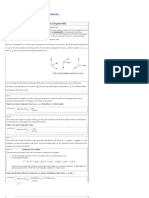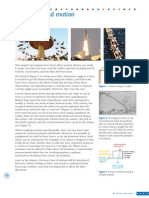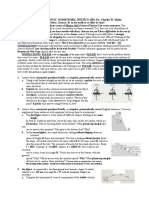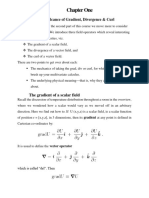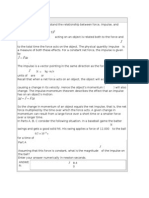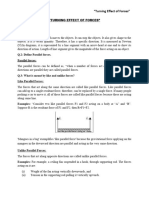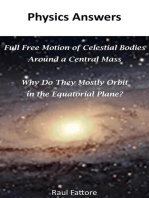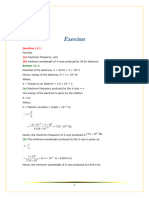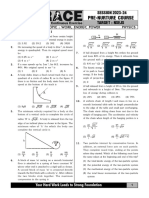P 201 F 08 HW 06 A
P 201 F 08 HW 06 A
Uploaded by
Venu Marakkini MCopyright:
Available Formats
P 201 F 08 HW 06 A
P 201 F 08 HW 06 A
Uploaded by
Venu Marakkini MOriginal Title
Copyright
Available Formats
Share this document
Did you find this document useful?
Is this content inappropriate?
Copyright:
Available Formats
P 201 F 08 HW 06 A
P 201 F 08 HW 06 A
Uploaded by
Venu Marakkini MCopyright:
Available Formats
MasteringPhysics: Assignment Print View
Page 1 of 16
Assignment Display Mode: View Printable Answers
IUPhysicsP201F2009
Assignment 6a
Due at 12:00pm on Tuesday, October 14, 2008
View Grading Details
Impulse on a Baseball
Description: Calculation of the impulse and momentum change on a baseball. Learning Goal: To understand the relationship between force, impulse, and momentum. The effect of a net force acting on an object is related both to the force and to the total time the force acts on the is a measure of both these effects. For a constant net force, the impulse is
object. The physical quantity impulse given by
The impulse is a vector pointing in the same direction as the force vector. The units of
are
or
Recall that when a net force acts on an object, the object will accelerate, causing a change in its velocity. Hence the object's momentum ( ) will also change. The impulse-momentum theorem describes the effect that an impulse has on an object's motion: . So the change in momentum of an object equals the net impulse, that is, the net force multiplied by the time over which the force acts. A given change in momentum can result from a large force over a short time or a smaller force over a longer time. In Parts A, B, C consider the following situation. In a baseball game the batter swings and gets a good solid hit. His swing applies a force of 12,000 to the ball for a time of .
Part A Assuming that this force is constant, what is the magnitude Enter your answer numerically in newton seconds. ANSWER: = of the impulse on the ball?
http://session.masteringphysics.com/myct/assignmentPrint?assignmentID=1158635
10/6/2008
MasteringPhysics: Assignment Print View
Page 2 of 16
We often visualize the impulse by drawing a graph of force versus time. For a constant net force such as that used in the previous part, the graph will look like the one shown in the figure.
Part B The net force versus time graph has a rectangular shape. Often in physics geometric properties of graphs have physical meaning. ANSWER: For this graph, the area of the rectangle corresponds to the impulse.
The assumption of a constant net force is idealized to make the problem easier to solve. A real force, especially in a case like the one presented in Parts A and B, where a large force is applied for a short time, is not likely to be constant. A more realistic graph of the force that the swinging bat applies to the baseball will show the force building up to a maximum value as the bat comes into full contact with the ball. Then as the ball loses contact with the bat, the graph will show the force decaying to zero. It will look like the graph in the figure.
http://session.masteringphysics.com/myct/assignmentPrint?assignmentID=1158635
10/6/2008
MasteringPhysics: Assignment Print View
Page 3 of 16
Part C If both the graph representing the constant net force and the graph representing the variable net force represent the same impulse acting on the baseball, which geometric properties must the two graphs have in common? ANSWER:
j k l m n maximum force i j k l m n area j k l m n slope
When the net force varies over time, as in the case of the real net force acting on the baseball, you can simplify the problem by finding the average net force acting on the baseball during time . This average net force is treated as a constant force that acts on the ball for time as . . The impulse on the ball can then be found
Graphically, this method states that the impulse of the baseball can be represented by either the area under the net force versus time curve or the area under the average net force versus time curve. These areas are represented in the figure as the areas shaded in red and blue respectively.
The impulse of an object is also related to its change in momentum. Once the impulse is known, it can be used to find the change in momentum, or if either the initial or final momentum is known, the other momentum can be found. Keep in mind that . Because both impulse and momentum are vectors, it is essential to account for the direction of each vector, even in a one-dimensional problem. Part D Assume that a pitcher throws a baseball so that it travels in a straight line parallel to the ground. The batter then hits the ball so it goes directly back to the pitcher along the same straight line. Define the direction the pitcher originally throws the ball as the +x direction. ANSWER: The impulse on the ball caused by the bat will be in the negative x direction.
http://session.masteringphysics.com/myct/assignmentPrint?assignmentID=1158635
10/6/2008
MasteringPhysics: Assignment Print View
Page 4 of 16
Part E Now assume that the pitcher in Part D throws a 0.145baseball parallel to the ground with a speed of 32 in
the +x direction. The batter then hits the ball so it goes directly back to the pitcher along the same straight line. What is the ball's velocity just after leaving the bat if the bat applies an impulse of to the baseball? Enter your answer numerically in meters per second. ANSWER: =
The negative sign in the answer indicates that after the bat hits the ball, the ball travels in the opposite direction to that defined to be positive.
The Center of It All
Description: The definitions of the center of mass and the center of gravity are introduced, along with the formulas for locating the center of mass. Students are required to complete several conceptual and computational questions that deal with systems of point particles. (version for algebra-based courses) Learning Goal: To learn the definition of the center of mass for systems of particles and be able to locate it. Imagine throwing a rock upward and away from you. With negligible air resistance, the rock will follow a parabolic path before hitting the ground. Now imagine throwing a stick (or any other extended object). The stick will tend to rotate as it travels through the air, and the motion of each point of the stick (taken individually) will be fairly complex. However, there will be one point that will follow a simple parabolic path: the point about which the stick rotates. No matter how the stick is thrown, this special point will always be located at the same position within the stick. The motion of the entire stick can then be described as a combination of the translation of that single point (as if the entire mass of the stick were concentrated there) and the rotation of the stick about that point. Such a point, it turns out, exists for every rigid object or system of massive particles. It is called the center of mass. To calculate the center of mass for a system of massive point particles that have coordinates the following equations are used: , and masses ,
In this problem, you will practice locating the center of mass for various systems of point particles. Part A Two particles of masses system located? ANSWER: and ( ) are located 10 meters apart. Where is the center of mass of the
j k l m n less than 5 meters from the particle of mass j k l m n exactly 5 meters from the particle of mass more than 5 meters but less than 10 meters from the particle of mass i j k l m n
http://session.masteringphysics.com/myct/assignmentPrint?assignmentID=1158635
10/6/2008
MasteringPhysics: Assignment Print View
Page 5 of 16
j k l m n more than 10 meters from the particle of mass
Part B For the system of three particles shown, which have masses mass located? , , and as indicated, where is the center of
ANSWER:
j k l m n to the left of the particle of mass and the particle of mass j k l m n between the particle of mass i j k l m n
between the particle of mass
and the particle of mass
j k l m n to the right of the particle of mass
Perhaps you "feel" that the center of mass should be located to the right of the particle of mass
, since the
particle to the right of it has greater mass than the particle to the left. A calculation, however, allows one to pinpoint the exact location of the center of mass. Part C For the system of particles described in Part B, find the x coordinate of the center of mass. Assume that the particle of mass is at the origin and the positive x axis is directed to the right. Express your answer in terms of ANSWER: = .
Part D Let us now consider a two-dimensional case. The system includes three particles of equal mass located at the
vertices of an isosceles triangle as shown in the figure. Which arrow best shows the location of the center of mass
http://session.masteringphysics.com/myct/assignmentPrint?assignmentID=1158635
10/6/2008
MasteringPhysics: Assignment Print View
Page 6 of 16
of the system? Do not calculate.
ANSWER:
j k l m n1 j k l m n2 j k l m n3 i j k l m n4 j k l m n5
Part E What is the x coordinate of the center of mass of the system described in Part D? .
Express your answer in terms of ANSWER: =
From the symmetry of the situation, you can see that the x and y coordinates of the center of mass are the same. Part F A system of four buckets forms a square as shown in the figure. Initially, the buckets have different masses (it is not known how these masses are related). A student begins to add water gradually to the bucket located at the origin. As a result, what happens to the coordinates of the center of mass of the system of buckets?
http://session.masteringphysics.com/myct/assignmentPrint?assignmentID=1158635
10/6/2008
MasteringPhysics: Assignment Print View
Page 7 of 16
Hint F.1
The movement of the center of mass
As the bucket at the origin gets heavier, will the center of mass move closer to the origin or away from it? ANSWER:
j k l m n The x coordinate stays the same; the y coordinate increases. j k l m n The x coordinate stays the same; the y coordinate decreases. j k l m n The x coordinate increases; the y coordinate stays the same. j k l m n The x coordinate decreases; the y coordinate stays the same. j k l m n The x coordinate increases; the y coordinate increases. i j k l m n The x coordinate decreases; the y coordinate decreases. j k l m n The x coordinate stays the same; the y coordinate stays the same. j k l m n There is not enough information to answer the question.
Part G Find the x coordinate of the center of mass of the system of particles shown in the figure.
Express your answer in meters to two significant figures.
ANSWER:
Part H Find the y coordinate of the center of mass of the system of particles described in the previous part. Express your answer in meters to two significant figures. ANSWER: =
http://session.masteringphysics.com/myct/assignmentPrint?assignmentID=1158635
10/6/2008
MasteringPhysics: Assignment Print View
Page 8 of 16
Introduction to Collisions
Description: Basic questions about two disks colliding, elastically and perfectly inelastically, with varied mass ratios. General definition of elasticity of a collision introduced in the last part. Uses applet. (version for algebrabased courses) Learning Goal: To understand how to find the velocities of objects after a collision. There are two main types of collisions that you will study: perfectly elastic collisions and perfectly inelastic collisions. When two objects collide elastically, both total kinetic energy and total momentum are conserved. These two conservation laws allow the final motion of the two objects to be determined. When two objects collide inelastically, total momentum is conserved, but the total kinetic energy is not conserved. After an inelastic collision the two objects are stuck together, and thus travel with the same final velocity; this fact, together with conservation of momentum, allows the final motion of the two objects to be calculated. In reality, there is a range of collision types, with elastic and perfectly inelastic at the extreme ends. These extreme cases allow for a more straightforward analysis than the in-between cases. The applet at the end of the problem will give you a chance to explore the "in-between" collisions. Let two objects of equal mass initially stationary. Part A If the collision is perfectly elastic, what are the final velocities Hint A.1 How to approach the problem In analyzing any collision, you can always use conservation of momentum as long as there are no external forces acting on the colliding objects. In elastic collisions you can also use the conservation of kinetic energy. Each of these conservation laws will allow you to write down an equation relating , , and . Once you have the equations, use algebra to eliminate from the system to get a formula for in terms of . Then, go back to the original system and eliminate to get a formula for in terms of . Part A.2 Find the equation that results from conservation of momentum and of objects 1 and 2? collide. Object 1 has initial velocity , directed to the right, and object 2 is
Which of the following equations correctly expresses conservation of momentum for the two objects? ANSWER:
i j k l m n
j k l m n
j k l m n j k l m n j k l m n j k l m n
Since the objects have equal mass, the term .
will factor out of both sides of the equation, leaving
http://session.masteringphysics.com/myct/assignmentPrint?assignmentID=1158635
10/6/2008
MasteringPhysics: Assignment Print View
Page 9 of 16
Part A.3
Find the equation that results from conservation of energy
Which of the following equations correctly expresses conservation of energy for the two objects? ANSWER:
j k l m n
j k l m n
j k l m n j k l m n
i j k l m n j k l m n
Since the objects have equal mass, .
(and a factor of
) will factor out of the equation, leaving
Give the velocity of object 1 followed by the velocity velocity in terms of . ANSWER: =
of object 2, separated by a comma. Express each
Part B Now suppose that the collision is perfectly inelastic. What are the velocities collision? Hint B.1 How to approach the problem and of the two objects after the
In analyzing any collision, you can always use conservation of momentum. In perfectly inelastic collisions you can also use the fact that the final velocities of the objects are equal. Each of these facts will allow you to write down an equation relating , , and . Once you have the equation from conservation of momentum, simply substitute using the equation to find the final velocity of each object in terms of . Part B.2 Find the equation that results from conservation of momentum
Which of the following equations correctly expresses conservation of momentum for the two objects? ANSWER:
j k l m n
j k l m n
j k l m n j k l m n
j k l m n
http://session.masteringphysics.com/myct/assignmentPrint?assignmentID=1158635
10/6/2008
MasteringPhysics: Assignment Print View
Page 10 of 16
j k l m n
Since the objects have equal mass, the term .
will factor out of both sides of the equation, leaving
Give the velocity of object 1 followed by the velocity velocities in terms of . ANSWER: =
of object 2, separated by a comma. Express the
Part C Now assume that the mass of object 1 is are the final velocities and , while the mass of object 2 remains . If the collision is elastic, what
of objects 1 and 2?
Hint C.1 How to approach the problem In analyzing any collision, you can always use conservation of momentum. In elastic collisions you can also use the conservation of kinetic energy. Each of these conservation laws will allow you to write down a linear equation relating , , and . Once you have the equations, you can use algebra to eliminate from the system to get a formula for in terms of . Then, go back to the original system and eliminate to get a formula for in terms of . Part C.2 Find the equation that results from conservation of momentum
Which of the following equations correctly expresses conservation of momentum for the two objects? ANSWER:
j k l m n i j k l m n
j k l m n j k l m n
j k l m n
j k l m n
Notice that
will factor out of both sides of the equation, leaving
Part C.3
Find the equation that results from conservation of energy
Which of the following equations correctly expresses conservation of kinetic energy for this part? ANSWER:
http://session.masteringphysics.com/myct/assignmentPrint?assignmentID=1158635
10/6/2008
MasteringPhysics: Assignment Print View
Page 11 of 16
j k l m n j k l m n
j k l m n j k l m n
i j k l m n
j k l m n
Notice that
will divide out of the equation, leaving
Give the velocity of object 1 followed by the velocity velocities in terms of . ANSWER: =
of object 2, separated by a comma. Express the
Note that in both the conservation of momentum equation and the conservation of energy equation, cancels out. This is a general feature of many collision situations: The ratio of the two masses is important, but the absolute masses are not. Part D Let the mass of object 1 be and the mass of object 2 be . If the collision is perfectly inelastic, what are the velocities of the two objects after the collision? Hint D.1 How to approach the problem In analyzing any collision, you can always use conservation of momentum. In perfectly inelastic collisions you can also use the fact that the final velocities of the objects are equal. Each of these facts will allow you to write down an equation relating , , and . Once you have the equation from conservation of momentum, simply substitute using the equation to find the final velocity of each object in terms of . Part D.2 Find the equation that results from conservation of momentum
Which of the following equations correctly expresses conservation of momentum for the two objects? ANSWER:
i j k l m n j k l m n
j k l m n j k l m n
http://session.masteringphysics.com/myct/assignmentPrint?assignmentID=1158635
10/6/2008
MasteringPhysics: Assignment Print View
Page 12 of 16
j k l m n
j k l m n
Notice that
will factor out of both sides of the equation, leaving
Give the velocity of object 1 followed by the velocity velocities in terms of . ANSWER: =
of object 2, separated by a comma. Express the
This applet shows two disks colliding. The orange disk always has the same initial velocity. You can change the ratio of the masses of the two disks as well as the elasticity of the collision. is a measure of how elastic a collision is; a perfectly elastic collision has elasticity elasticity to see how the value of the elasticity affects the various collisions. , while a perfectly inelastic collision has . You should use the applet to reproduce the collisions of Parts A-D. You can then adjust
A Bullet Is Fired into a Wooden Block
Description: Conceptual: A bullet embeds in a stationary, frictionless block: type of collision? what is conserved? v_final? A bullet of mass is fired horizontally with speed at a wooden block of mass resting on a frictionless table. The bullet hits the block and becomes completely embedded within it. After the bullet has come to rest within the block, the block, with the bullet in it, is traveling at speed .
Part A Which of the following best describes this collision?
http://session.masteringphysics.com/myct/assignmentPrint?assignmentID=1158635
10/6/2008
MasteringPhysics: Assignment Print View
Page 13 of 16
Hint A.1 Types of collisions An inelastic collision is a collision in which kinetic energy is not conserved. In a partially inelastic collision, kinetic energy is lost, but the objects colliding do not stick together. From this information, you can infer what completely inelastic and elastic collisions are. ANSWER:
j k l m n perfectly elastic j k l m n partially inelastic i j k l m n perfectly inelastic
Part B Which of the following quantities, if any, are conserved during this collision? Hint B.1 When is kinetic energy conserved?
Kinetic energy is conserved only in perfectly elastic collisions. ANSWER:
j k l m n kinetic energy only i j k l m n momentum only j k l m n kinetic energy and momentum j k l m n neither momentum nor kinetic energy
Part C What is the speed of the block/bullet system after the collision? Part C.1 Find the momentum after the collision of the block/bullet system after the collision? and other given quantities.
What is the total momentum Express your answer in terms of ANSWER: =
Part C.2
Use conservation of momentum
The momentum of the block/bullet system is conserved. Therefore, the momentum before the collision is the same as the momentum after the collision. Find a second expression for , this time expressed as the total momentum of the system before the collision. Express your answer in terms of ANSWER: = , , and . and other given quantities.
Express your answer in terms of ANSWER: =
http://session.masteringphysics.com/myct/assignmentPrint?assignmentID=1158635
10/6/2008
MasteringPhysics: Assignment Print View
Page 14 of 16
Kinetic Energy and Momentum Conceptual Question
Description: Conceptual question on using kinetic energy and momentum to analyze motion. The two toy cars shown in the figure, with masses as given in the figure, are ready to race. Both cars begin from rest. For each question, state whether the correct answer is car A, car B, or whether the two cars have equal values for the parameter in question.
For the next three parts assume that the cars' motors supply the same force to each car over the course of a 1.0meter race. Part A Which car crosses the finish line 1.0 away first?
Hint A.1 Three ways to analyze motion Newton's second law, the work-energy relation, and the impulse-momentum relation can all be used to draw conclusions about the forces that act on an object and the object's motion. Which approach to use depends on the information given in the problem statement and the information you are trying to determine. In this case, you are asked a kinematic question, so you should use the technique that will give you a useful kinematic quantity such as acceleration or initial velocity. ANSWER:
j k l m n Car A wins i j k l m n Car B wins j k l m n Both cars cross the finish line at the same time.
Part B Which car has the larger kinetic energy when it crosses the finish line 1.0 Hint B.1 The work-energy relation away?
Since both cars start from rest and move in the same direction, the work done on each car is equal to its final kinetic energy. Recall that work is given as the product of applied force (parallel to the direction of motion) and the distance over which the force is applied. Notice you are told about both force and distance in the description of the race. ANSWER:
j k l m n Car A j k l m n Car B
Both cars have the same kinetic energy.
http://session.masteringphysics.com/myct/assignmentPrint?assignmentID=1158635
10/6/2008
MasteringPhysics: Assignment Print View
Page 15 of 16
i j k l m n
Part C Which car has a larger momentum when it crosses the finish line 1.0 Hint C.1 The impulse-momentum relation Since both cars start from rest, the impulse applied to each car is equal to its final momentum. Recall that impulse is given as the product of applied force and the time interval over which the force is applied. You are given the equality of the forces in the description of the race. The time is the subject of Part A. ANSWER:
i j k l m n Car A j k l m n Car B j k l m n Both cars have the same momentum.
away?
In the the next three parts we analyze a different type of race, in which the cars' motors supply the same force to each car over the course of a 10-second race. Part D Which car has traveled farther after 10 ? ANSWER:
j k l m n Car A i j k l m n Car B j k l m n Both cars travel the same distance.
Part E After 10 Hint E.1 which car has a larger kinetic energy? The work-energy relation
Since both cars start from rest and move in the same direction, the work done on each car is equal to its final kinetic energy. Recall that work is given as the product of applied force (parallel to the direction of motion) and the distance over which the force is applied. You are given the equality of the forces in the description of the second race. The distance is the subject of Part D. ANSWER:
j k l m n Car A i j k l m n Car B j k l m n Both cars have the same kinetic energy.
Part F After 10 Hint F.1 which car has a larger momentum? The impulse-momentum relation
Since both cars start from rest, the impulse applied to each car is equal to its final momentum. Recall that impulse is given as the product of applied force and the time interval over which the force is applied. Notice you are told
http://session.masteringphysics.com/myct/assignmentPrint?assignmentID=1158635
10/6/2008
MasteringPhysics: Assignment Print View
Page 16 of 16
about both force and time in the description of the second race. ANSWER:
j k l m n Car A j k l m n Car B i j k l m n Both cars have the same momentum.
Summary
0 of 5 items complete (0% avg. score) 0 of 5 points
http://session.masteringphysics.com/myct/assignmentPrint?assignmentID=1158635
10/6/2008
You might also like
- CH 06 HWDocument40 pagesCH 06 HWAliciaTorres76% (33)
- The Physics of Energy Solution ManualDocument141 pagesThe Physics of Energy Solution ManualMohammed Shariq AyjazNo ratings yet
- Physics Homework #10 (SOLUTIONS)Document10 pagesPhysics Homework #10 (SOLUTIONS)nsharma1000No ratings yet
- Solutions) Mastering Physics HW20Document8 pagesSolutions) Mastering Physics HW20Alex DalyNo ratings yet
- HWCH 9Document6 pagesHWCH 9Anonymous hht06lypm1No ratings yet
- Chapter 13 Skill BuildingDocument26 pagesChapter 13 Skill BuildingNKHICQ1mEbIwNo ratings yet
- HW 8 AnsDocument14 pagesHW 8 AnsKristin Dikiciyan100% (5)
- f1007b Exam - en Antonio Delgado A01707634Document9 pagesf1007b Exam - en Antonio Delgado A01707634Antonio Delgado SalgadoNo ratings yet
- Forces and Motion: L L L LDocument8 pagesForces and Motion: L L L LeibsourceNo ratings yet
- Review/Diagnostic Homework, Physics 4304, Dr. Charles W. MylesDocument5 pagesReview/Diagnostic Homework, Physics 4304, Dr. Charles W. MylesNur SyahirahNo ratings yet
- AP Physics: - Gravity WrapupDocument11 pagesAP Physics: - Gravity WrapupCash Cash CashNo ratings yet
- The Physical Pendulum MPDocument19 pagesThe Physical Pendulum MPKyle Donaghey100% (2)
- Simple Harmonic OscillationsDocument26 pagesSimple Harmonic OscillationsKyle DonagheyNo ratings yet
- Forces and Static Equilibrium - WorksheetDocument7 pagesForces and Static Equilibrium - WorksheetdebbyhooiNo ratings yet
- MechanixDocument39 pagesMechanixShikta TopsheNo ratings yet
- Power, Work and Energy PDFDocument14 pagesPower, Work and Energy PDFFRANCES VISAYANo ratings yet
- Simple Harmonic Oscillations MPDocument26 pagesSimple Harmonic Oscillations MPKyle Donaghey50% (12)
- Mec IDocument15 pagesMec Iali ahmedNo ratings yet
- Hooke's Law: Hooke's Law. Today's Lab Will Allow You To Test The Accuracy of Hooke's Law For A SimpleDocument5 pagesHooke's Law: Hooke's Law. Today's Lab Will Allow You To Test The Accuracy of Hooke's Law For A SimpleVASIREDDY K V PAVAN KUMAR V Venugopal RaoNo ratings yet
- NoessDocument7 pagesNoessarpita9619080670No ratings yet
- PC1431 Assignment 2 AnswersDocument19 pagesPC1431 Assignment 2 AnswersMikael Lee0% (3)
- HWCH 11Document9 pagesHWCH 11Eric BarberNo ratings yet
- Lecture 15 & 16 Work and EnergyDocument12 pagesLecture 15 & 16 Work and Energyrizal123No ratings yet
- AP Phys1 Momentum AP Style Free Response Questions 2019-11-13Document18 pagesAP Phys1 Momentum AP Style Free Response Questions 2019-11-13YazaanNo ratings yet
- Lesson 1 Oscillations V 2023Document13 pagesLesson 1 Oscillations V 2023ANGELA DE LEONNo ratings yet
- Physics 4A Chapter 5: Force and Motion - I: Reading: OutlineDocument8 pagesPhysics 4A Chapter 5: Force and Motion - I: Reading: OutlineHasan MehediNo ratings yet
- MODULE 4.bDocument13 pagesMODULE 4.byrbbwababa05No ratings yet
- Sample Emc2Document6 pagesSample Emc2Prajwal DasNo ratings yet
- Homework Set # 4: Due Friday, September 21, 6pm PHYS 2210 (Fall 2018)Document4 pagesHomework Set # 4: Due Friday, September 21, 6pm PHYS 2210 (Fall 2018)Fredrick OduorNo ratings yet
- Work, Energy and PowerDocument27 pagesWork, Energy and PowersuperultimateamazingNo ratings yet
- Simplified Theory: Version: 28 Feb 06Document5 pagesSimplified Theory: Version: 28 Feb 06xiaochaiNo ratings yet
- Conservation Laws BPendulumDocument4 pagesConservation Laws BPendulumLuis PedreroNo ratings yet
- Virtual WorkDocument12 pagesVirtual Workdkgupta28No ratings yet
- Momentum: Nirmaan Shanker October 2015Document7 pagesMomentum: Nirmaan Shanker October 2015Nirmaan ShankerNo ratings yet
- Cape Physics Unit 1st EditionDocument70 pagesCape Physics Unit 1st EditionJunior Dollas100% (10)
- Spring Mass DamperDocument15 pagesSpring Mass DamperAeitesham Ul Huq SubedarNo ratings yet
- 3 Newton's LawsDocument3 pages3 Newton's LawsOmar Mostafa Hussien ヅNo ratings yet
- Laws of MotionDocument19 pagesLaws of MotionSubrata PaulNo ratings yet
- Derivation of Rectilinear Motion and Its ApplicationDocument15 pagesDerivation of Rectilinear Motion and Its Applicationcontactmahtab78667% (3)
- Systems of ParticlesDocument16 pagesSystems of Particleseka123No ratings yet
- Exploraciones Movimiento Circular Uniforme PDFDocument14 pagesExploraciones Movimiento Circular Uniforme PDFDanielaRodriguezNo ratings yet
- الملزمة الرئيسية الفيزياء Document54 pagesالملزمة الرئيسية الفيزياء m4332060No ratings yet
- A Force BoardDocument6 pagesA Force BoardMelissa A. BernardoNo ratings yet
- Emc 2Document7 pagesEmc 2avanomminerNo ratings yet
- MP 6Document12 pagesMP 6Krishna MahajanNo ratings yet
- Exam4 Phy113 F07 Final - KeyDocument10 pagesExam4 Phy113 F07 Final - Keyntarshish1No ratings yet
- Mastering Physics HW 6Document20 pagesMastering Physics HW 6ebaysellerweng0% (2)
- ap-phys1_uniform-circular-motion-ap-free-response-problems_2024-11-22Document16 pagesap-phys1_uniform-circular-motion-ap-free-response-problems_2024-11-22SOHAM AGGARWALNo ratings yet
- Chap 4 Turning Effect of ForcesDocument13 pagesChap 4 Turning Effect of ForcesMoomal AnsariNo ratings yet
- Ap Phys1 - Dynamics 2d Ap Style Free Response Questions - 2019 08 19Document27 pagesAp Phys1 - Dynamics 2d Ap Style Free Response Questions - 2019 08 19Abdullah MalikNo ratings yet
- MP EM Ass 14: Magnetic ForceDocument13 pagesMP EM Ass 14: Magnetic ForceBlueAstro100% (4)
- Stress TensorDocument25 pagesStress TensorJsvijay KumarNo ratings yet
- Work Energy UnderstandingDocument12 pagesWork Energy Understandingmbs_13_1953100% (2)
- Class 10 - Physics - Force SolutionsDocument32 pagesClass 10 - Physics - Force SolutionsAndrik LalNo ratings yet
- Full Free Motion of Celestial Bodies Around a Central Mass - Why Do They Mostly Orbit in the Equatorial Plane?From EverandFull Free Motion of Celestial Bodies Around a Central Mass - Why Do They Mostly Orbit in the Equatorial Plane?No ratings yet
- Theory of Elastisity, Stability and Dynamics of Structures Common ProblemsFrom EverandTheory of Elastisity, Stability and Dynamics of Structures Common ProblemsNo ratings yet
- Power, Momentum and Collisions - Physics for Kids - 5th Grade | Children's Physics BooksFrom EverandPower, Momentum and Collisions - Physics for Kids - 5th Grade | Children's Physics BooksNo ratings yet
- Mastering Physics HW 6Document20 pagesMastering Physics HW 6ebaysellerweng0% (2)
- Round 1: Each Question Carry 4 Point: Quiz Competition - 2019 (Text Book Based Questions, G.K, Applications)Document52 pagesRound 1: Each Question Carry 4 Point: Quiz Competition - 2019 (Text Book Based Questions, G.K, Applications)Sonamm YangkiiNo ratings yet
- Fizik p2 Mid Term 2015Document14 pagesFizik p2 Mid Term 2015darwishmajidNo ratings yet
- Skate Park LabDocument3 pagesSkate Park Labapi-319102793No ratings yet
- All India Integrated Test Series: JEE (Advanced) - 2022Document11 pagesAll India Integrated Test Series: JEE (Advanced) - 2022Deneb Shah ShahNo ratings yet
- 005 Momentum Impulse and Collisions PDFDocument23 pages005 Momentum Impulse and Collisions PDFNIEVA LOU ORBOCNo ratings yet
- Forms of EnergyDocument6 pagesForms of Energyapi-279793282100% (1)
- Work and Energy - Class 9 Science Notes UPSC GeDocument1 pageWork and Energy - Class 9 Science Notes UPSC GeSiddhantha GR-26-7I Technology Committee MemberNo ratings yet
- Physics Topic by Topic Grade 10 To 12 Q&A PDFDocument105 pagesPhysics Topic by Topic Grade 10 To 12 Q&A PDFMalama Lombe100% (1)
- Toddle 3eea88cf 80db 46f1 84b2 816035455156 Forces and MomentumDocument26 pagesToddle 3eea88cf 80db 46f1 84b2 816035455156 Forces and MomentumahmedalikassimnaelNo ratings yet
- Dual Nature of Radiation and VariationsDocument20 pagesDual Nature of Radiation and VariationsalgostockstradingNo ratings yet
- Conservation Laws: Benjamin CrowellDocument50 pagesConservation Laws: Benjamin CrowellDeepanshu GoyalNo ratings yet
- Undamped Free Vibration - RahulDocument47 pagesUndamped Free Vibration - Rahulrs100788100% (1)
- Siradjuddin 2019 J. Phys. Conf. Ser. 1402 044025Document7 pagesSiradjuddin 2019 J. Phys. Conf. Ser. 1402 044025Nguyen Phan LamNo ratings yet
- HW 6 - Phys - AnswersDocument17 pagesHW 6 - Phys - AnswersJohn GamboaNo ratings yet
- Intro To Energy WorksheetDocument2 pagesIntro To Energy WorksheetMelecia SeniorNo ratings yet
- Free Vibrations Analysis of A Rotating Shaft With Nonlinearities in Curvature and InertiaDocument17 pagesFree Vibrations Analysis of A Rotating Shaft With Nonlinearities in Curvature and InertiaParthipan JayaramNo ratings yet
- 15 - OscillationsDocument12 pages15 - OscillationsMohamedNo ratings yet
- Work Energy and Power: Module - 1Document34 pagesWork Energy and Power: Module - 1rgNo ratings yet
- Long Test in Science Grade 9Document3 pagesLong Test in Science Grade 9Janet PagulayanNo ratings yet
- Plunger Cart Instruction Manual ME 9430Document24 pagesPlunger Cart Instruction Manual ME 9430zia.mudassir2No ratings yet
- FarhadDocument6 pagesFarhadnasaenterprise1970No ratings yet
- B-Race - Work Energy Power (IJSO)Document4 pagesB-Race - Work Energy Power (IJSO)ShauryaNo ratings yet
- JEE-Compendium-Solutions-Physics-2Document144 pagesJEE-Compendium-Solutions-Physics-2ask463390No ratings yet
- Module 6 Work Energy and Power-Gen Phy 1Document19 pagesModule 6 Work Energy and Power-Gen Phy 1gregory jimenezNo ratings yet
- Energy TossDocument5 pagesEnergy Tossapi-357205912No ratings yet
- Physics SD 11.11 Phys.7BDocument38 pagesPhysics SD 11.11 Phys.7Bxavierlewis458No ratings yet
- Sec 3 Science SyllabusDocument5 pagesSec 3 Science SyllabusKajana Sivarasa ShenthanNo ratings yet
- Added MassDocument31 pagesAdded MassjdmorapNo ratings yet



